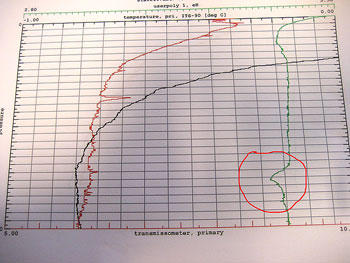Day 12 - 6 July
Today was the first day of poor weather. We had been told to expect foggy weather because this area is near a frontal zone of ocean currents, but while mostly overcast, the weather has been clear and the visibility good until today. However, our work does not depend on visibility so we continued as usual.
Main content
Position: 73N 8E
Temperature: 5.6 (air) 6.8 (water)
Wind speed: 9.1m/s
Wave height: 2.1m (average)
Visibility: poor
Weather: foggy
picture galleries:
scientists at work
fauna from cemented sediments
ROV still
The GOSars performed superbly overnight with a new "bouncing" CTD technique that involves linking casts in a series without removing the unit between casts. It is a surveying technique where the CTD probes are used over a broader area than when conducting complete single casts.
Unfortunately we continue to get conflicting results. Locations that gave good results a day or two ago, no longer give a signal, new signals are found in other areas ... The Eh (reduced chemical species) values may show an anomaly, but the gas chromatograph results on the water samples show nothing or vice versa. Today, for example, we had one of the highest values yet for methane in a water sample, but, although the hydrogen levels in the sample were high, they were not as proportionately high, possibly suggesting that the dissolved gases were "old" having drifted for a day or two.
As cruise leader Rolf-Birger Pedersen explains, this seems to give a different signal than a typical black smoker field. We have found a distinct anomaly here, but it may be a new or unusual kind of vent field. All we can do is accumulate more data to locate it.
The new ROV has continued to perform very well at depth (the deepest ever for a Norwegian ROV). We have seen much evidence of volcanic activity with numerous lava fields.
There is a great deal of marine snow both in the water column and on the sea-floor, where it has drifted to considerable depth in some areas.
In our first dive two days ago we found a tree "fall" that showed evidence of extensive microbial colonisation. Today we were able to return to the site at around 2900m and have collected a sample for further study.
Encounters with "Dumbo"
In each of our dives we have had an encounter with a "dumbo" type octopus, identified as a Cirroteuthis muelleri by Mike Vecchione from the National Systematics Laboratory, at the Smithsonian National Museum of Natural History. (for more information) In today's dive we were able to film the octopus for over 8 minutes as it calmly swam around the ROV.
ROV gallery
Yesterday's ROV dive collected some cemented sediment material - sediments that show evidence of fluid flow. The microbiologists may have found some iron and sulphur oxidising organisms in the samples. Lise Øvreås explains that they will investigate them further back in Bergen.
Geochemist Ingunn Thorseth explains that while the structural changes in the sediment could be purely the result of geochemical processes, the presence of specialised microbes in the sediments speeds up the process of crust formation. She underlined how critical it is for geochemists to collaborate closely with microbiologists in this kind of work.
After the microbiologists had taken their samples of the crusty material and muddy sediments, biologist and Christoffer Schander filtered the rest for larger fauna. He found a number of interesting organisms.
Researchers are investigating the stepping stone nature of hydrothermal communities and whether large natural barriers, such as Iceland, affect the community make-up south of Iceland as compared with north of Iceland.
